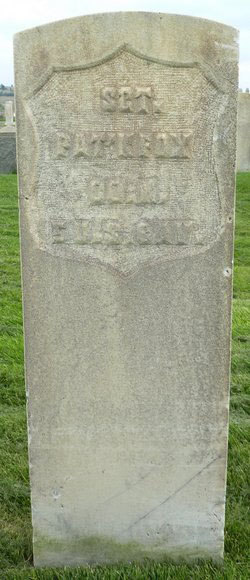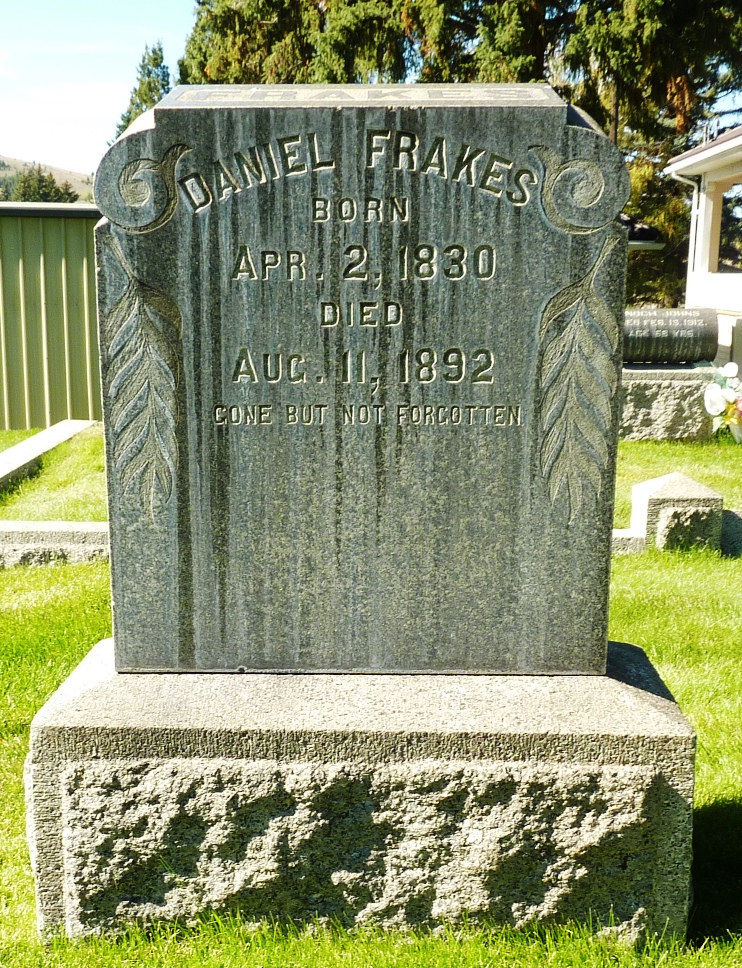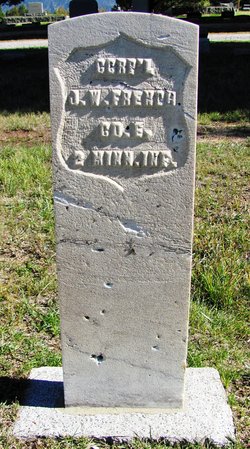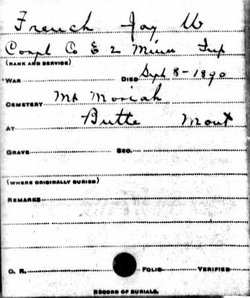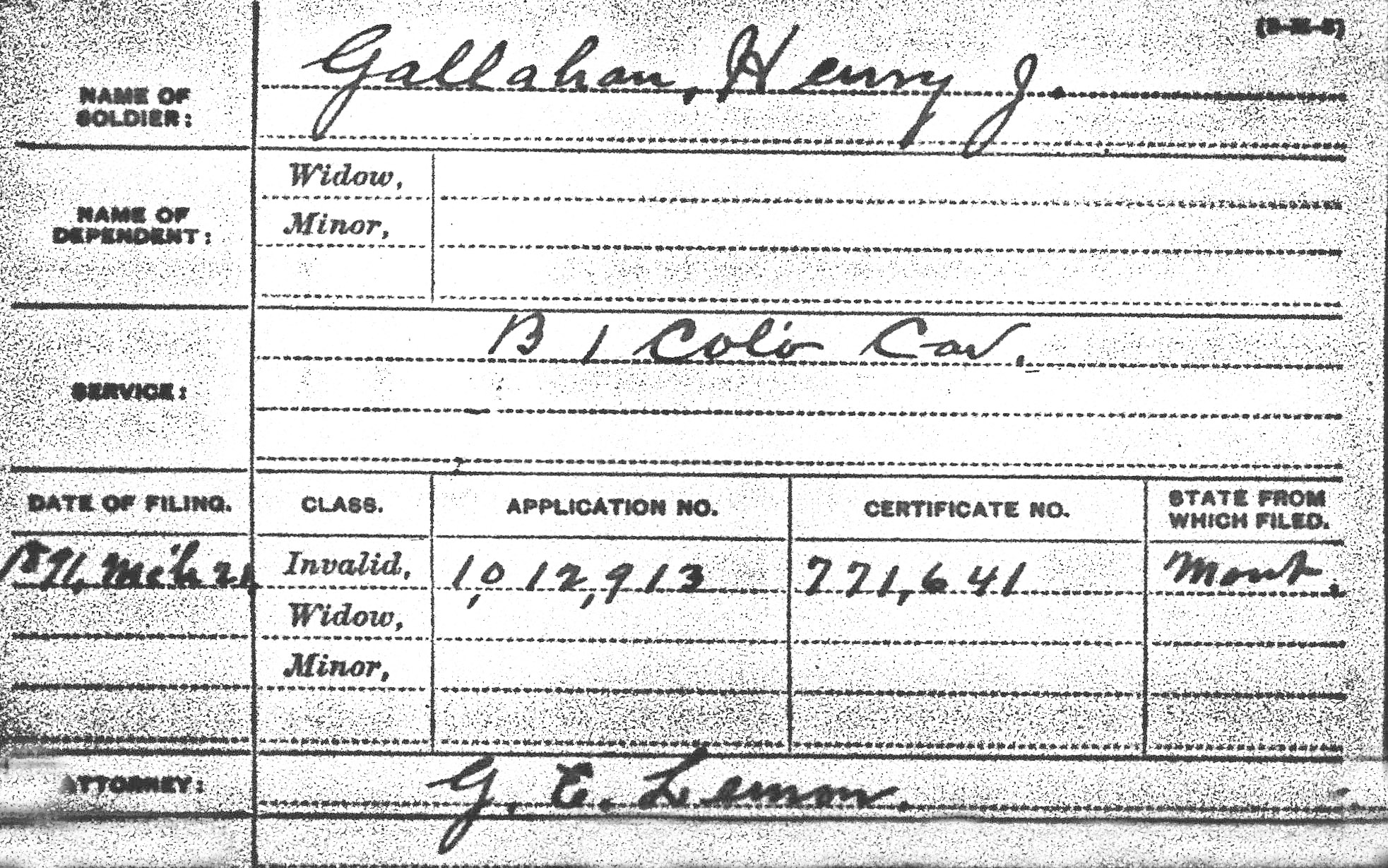|
EVIDENCE
IS NOT STRONG
Only Circumstantial Evidence Is Brought
Out
in the Latest Butte Murder Case
Special
by Leased Wire.
Butte, Oct.
25.—Neither the verdict of the coroner’s jury nor the testimony
introduced at the inquest, held tonight at Richards’ undertaking
rooms, in the case of Henry J. Gallahan, found fatally shot and stabbed
near the school of mines Monday evening, made the case against Miles
Fuller, held on suspicion of being the murderer, much stronger.
The jury found that the deceased came to his end from a stab and
a gunshot wound inflicted by some person or persons unknown, suspicion
being thrown on Fuller, however. The
jury finding that, according to the evidence, it was Fuller’s gun
found under Gallahan’s body.
So far everything goes to show circumstantially that Fuller was
the man who put an end to the old placer miner’s life, but there is as
yet no a person who can identify Fuller as the man who was seen by
several witnesses dueling with Gallahan. There is nothing in the way of
description offered by the several witnesses, and although one man at
the inquest tonight identified the gun found under Gallahan’s body as
being Fullers, and although two witnesses claim to have seen Fuller
following and watching the murdered man shortly before the tragedy,
identification of the man who actually did the shooting is lacking in
every particular.
There was a great deal of immaterial evidence introduced at the
inquest tonight, and the only witnesses who produced anything
approaching a sensation were those who told of seeing Fuller following
Gallahan, and the man who positively identified the weapon found under
the dead man’s body as being Fuller’s.
The undertaking rooms were crowded by the curious when Coroner
Egan swore in the witnesses. County
Attorney Breen conducted the inquest, asking most of the questions.
Fuller was present, being represented by Attorneys Lindsey and
Baldwin. Fuller was asked if he wished to testify, but he was advised by
his legal counsel to say nothing and he did not take the stand at all.
Great Falls Tribute
Great Fall, Montana
10/26/1904
INQUEST OVER BODY OF
GALLAHAN
Coroner Inquires Into the
Death of the Placer Miner
Who Was Murdered Monday Evening—Damaging
Evidence Against Fuller, the Suspect Who Is Now in Custody
New evidence of a damaging character was brought to light yesterday
that points the finger of suspicion at Miles Fuller as the murderer of Henry
J. Gallahan, the pioneer placer miner and prominent member of Lincoln post
of the Grand Army of the Republic, who was killed in a lonely spot near the
school of mines at 6 o’clock Monday night.
The finding of the sheriff’s officers and the testimony adduced at
the inquest held over the remains of the murdered man at Richards’
undertaking rooms last night all tend to fasten the crime upon Fuller, who
was arrested in his cabin by Sheriff Quinn shortly after the tragedy and is
now held a prisoner at the county jail.
Tracks into which the shoes of Fuller fit perfectly were followed by
officers from the spot where the shooting occurred directly to the cabin of
the prisoner. Then, the most
import facts brought out at the coroner’s inquiry into the cause of death
are to the effect that Fuller was seen at 5:45 o’clock Monday night
crouching behind a corner of the McKinley school on West Park street, spying
upon the movements of Gallahan, who had just passed west.
Herschel J. Warfield, a student at the school of mines, who is
acquainted with both Fuller and Gallahan, gave this testimony, and added
that fuller acted in a peculiar and suspicious manner.
The verdict of the coroner’s jury, given after hearing a large
volume of evidence, was non-committal to the effect that Henry J. Gallahan
came to his death as the result of a bullet wound over the left eye and
knife cuts severing the jugular being on the right side of the neck,
inflected by some person unknown. But,
added to this was the sentence: “The revolver of Miles Fuller was found
under the dead body of the deceased.” This was according to the evidence
of one witness, who identified the gun as the one with which Fuller had
threatened his life and which he carried constantly.
Arrangements for the funeral were completed, and it will be held
under the auspices of Lincoln post of the G. A. R. at Richards’
undertaking rooms at 10 o’clock tomorrow morning.
Fuller
at the Inquest
Fuller was the center of
interest at the inquest. He
entered late in the custody of Sheriff Quinn and Deputy Sheriff William
Haggerty and took a seat near that occupied by the witnesses. During the
greater part of the hearing a derisive smile played over his cold, hard,
grizzled features, to be replaced by a look of anger, flashing like flames
from his gray, sneering eyes when the words of the witnesses were of a
damaging character. Fuller wears
a long, full beard, black once, but now tinged with gray, and was dressed
shabbily in overalls, long coat and black slouch hat, all showing the
results of wear and hard usage. His
hands are rough and calloused and are evidently those of a hard worker.
County Attorney Peter Breen assisted Coroner Egan in examining the
witnesses and John Lindsay and Attorney James H. Baldwin appeared as counsel
for Fuller. The latter would not allow the suspected murderer to take the
stand. The witnesses were
William Semmons, Gus Almquist, 16-year-old Bessie Bray, J. H. Bishop, Hubert
F. Harrington, Thomas J. Cook and Thurman Bray, all living in the vicinity
of the scene of the shooting and among the first to reach the spot where
Gallahan lay dying. Others put
on the stand were Dr. John C. Schapps, who, with Dr. W. H. Haviland,
performed an autopsy on the body of Gallahan yesterday morning; Hershel J.
Warfield and John F. Duggan, who saw Fuller and Gallahan on West Park street
about 15 minutes before the shooting occurred; John H. Gooch, who identified
the revolver found under Gallahan’s body as Fuller’s, and James Sweeney,
W. E. R. McDonald, G. Lasker and Elijah Boyer, all of whom had heard Fuller
threaten Gallahan’s life.
Gus
Almquist’s Testimony
Gus Almquist was on the scene when the first shot was fired he said.
His evidence, in effect, follows:
“I am working at the Bell mine and live at 1,235 West Platinum
street. I was on my way home
from work across the gulch below the school of mines, when my attention was
attracted by a sound not far distant. It
was not a shot, but as I looked up there was the flash of a gun.
Just 65 paces away, as I found afterward by stepping off the
distance, were two figures, both crouched down on one knee, I judged, but
they were not plainly discernable to me, for it was growing dark.
The upper one proved afterwards to be Gallahan.
The first shot was fired by the man at the lower side. The second
shot quickly flashed out from the gun of the upper man, and the third almost
instantly followed from his opponent. I
yelled, “What in ___are you doing?”
and then the man at the lower side raised up and circled about the
other, putting me almost in line with Gallahan’s fire. The fourth report
came from his gun, and I heard the bullet whistle past my head.
Then the one who had circled around fired the fifth and last shot,
and the one who afterward proved to be Gallahan fell to the ground.
I believe it was this shot that took effect over his eye.
I yelled for help as loud as I could, but was afraid to approach
nearer. The one who fired the
last shot then started as if to go away, but returned after taking only a
few steps and stooped over the prostrate form, his right hand at his breast.
Thinks
He Drew a Knife
“His movements
were hidden from me by a bush, but I believe he drew a knife from an inner
pocket and then inflicted the wounds in the neck. It looked as if he took
something from the dead man’s breast.
Semmons came up about that time and I asked if he had a gun and he
said no, and I told him to get one, which he did, getting it from the house.
By that time the man had arisen and was running off toward the
railroad track below the school of mines.
I ran to the man on the ground whom I recognized as Gallahan.
I had known him for 10 or 12 years and knew Fuller slightly, but
could not identify him as the one who shot Gallahan.
It was growing dark, and the fading light struck across my face as I
watched the duel. I was the
first to reach Gallahan’s side after the shooting.
He was lying on his face with his right hand raised to his head and
his left bent under his body. Blood poured from both wounds, especially from
the one in the neck. He was not
dead, and I reached him he partly turned over and raised up with his face
toward me. He was not able to speak, and I could see he would not live but a
few moments.” Almquist then told of going after the man who had made off.
Williams Semmons was before him.
Semmons
Saw the Duel
Semmons took the
witness stand and told of seeing the duel from a distance of a stone’s
throw. He was the second one on
the scene besides the participants and said he ran out of his home, which is
close by, attracted by the first shot. The he saw shots exchanged, and after
the man fell ran after the one who made off, going first northwest and then
west along the railroad track. He
couldn’t get to see the man’s face, for the latter held his head low and
crouched, the witness testified. He
described the fugitive as wearing a long, dark coat and slouch hat and with
a peculiar running gait. It was impossible to overtake the man and the chase
was given up.
Both Semmons and Almquist had heard Gallahan speak of his enemy some
weeks ago, and Almquist knew of the trouble he had had with Fuller
over the robbing of certain sluice boxes belonging to the dead man.
J. H Bishop gave the same account of the duel, seen from a greater
distance above.
Huntington
Found the Revolver
Hubert Huntington
testified that he turned the body of Gallahan over on its back and found the
revolver, afterward identified by John Goech as belonging to Fuller.
How this gun, if it is not the one used by Gallahan during the duel,
happened to be under the dead body, is a question that is puzzling the
officers. One theory advanced is
that when Gallahan’s opponent bent over him to finish his job with a
knife, he dropped the gun to draw the blade, and when the deed was done
hastily grabbed for the first gun that came to hand and accidentally got
Gallahan’s instead of his own.
Dr. Schapps described the wounds found upon Gallahan’s body at the
autopsy. There were only two.
The bullet wound extended from an entrance over the left eye to just
under the skin behind the left ear, having passed through the brain.
The bullet was much battered up and shapeless.
It was thought to be about a 44 or 45 caliber.
The physician testified that it was his opinion that the wound in the
neck was that of a knife ripping forward and backward, thus causing the
V-shaped wound. It was three
inches long and deep, he testified, completely severing the jugular vein and
cutting the carotid artery. Either
wound, he believe, would have caused death.
Saw
Fuller Acting Suspiciously
Herschel Warfield
was one of the most important witnesses.
He said that he left the school of mines about 5:45 o’clock Monday
afternoon, going east on Park street in company with John S. Duggan, also a
student. He said he had known
Fuller by the name of “Lizzie,” or “Lizzie Block,” as a man with a
hard reputation for the last five years, and it was this fact that attracted
his attention when he saw him standing being the southeast corner of the
McKinley school. He continued:
“We had just passed Gallahan, whom I have known for some time,
crossing west of the school. Fuller
was acting peculiarly, and I turned to see what he was doing.
He peeked around the corner, intently watching Gallahan, who stopped
on the bridge to light his pipe. I
didn’t think any more about it, and we went on.”
Duggan had not observed so closely, not knowing the men, but
corroborated Warfield’s testimony and told of seeing Gallahan descend the
steep embankment, going south after crossing the bridge.
This would be in the direction of his cabin and also the scene where
the shooting took place shortly afterwards.
Gallahan
Borrowed a Revolver
James Sweeney, a friend of Gallahan, told of advising the latter to
go armed after finding strychnine in his sugar.
He testified that Gallahan borrowed a revolver from “Old Henry,”
a hack driver, and he thought it was of 38 caliber with a black handle and
not the revolver exhibited as that found under Gallahan’s dead body.
Gallahan had told Sweeney that Fuller would kill him if he got a
chance. John Goech not only
identified the gun as that of Fuller, but told of hearing Fuller threaten to
kill Gallahan only three weeks ago, when the latter was riding on a wagon
with the witness down near the Tivoil brewery.
Goech said Gallahan was afraid of Fuller.
Pointing to the revolver on the table, the witness exclaimed: “He
put that same gun in my face about a year ago.
I’d know it 20 years from now.”
W. E. R. McDonald testified that Fuller told him last June he would
make a corpse of Gallahan before snow flew.
This was the result, the witness thought of difficulty between the
two over placer ground extending as far back as nine years ago.
Shoes
Fit the Tracks
The shoes worn by Fuller were taken into custody and are unusual in
shape. They were taken by Under
Sheriff McGarvey and Deputy Kirby to the scene of the shooting yesterday and
they fitted into the tracks leading toward the railroad tracks.
These tracks could not be followed along the track for about
one-eighth of a mile, but were found leading away and were never lost
until they entered the cabin of Fuller.
Deputy Sheriff Kirby made a search of the cabin and brought away two
long coats, one a cutaway had thought to be the garment as described as the
long coat worn by the man who left the scene of the shooting.
Such a coat Fuller wore when seen by Warfiled near the McKinley
school, the man said, contrary to the statement made by Fuller, who argued
that he went to town in overalls and a jumper.
Nothing else of interest was found in Fuller’s cabin.
Fuller is a native Texan and is said to have been a deep rebel
sympathizer during the civil war, although not a soldier.
He has been heard to give expression to his hatred of the union
soldiers and the G. A. R. men in most bitter terms.
Fuller left Texas bearing not the best reputation, according to those
who know his history and went to Oakland, Cal.
He had three children then, but left his family in Oakland and came
to Montana and has not heard from his wife since 1882.
One of the children is known to have died and one to have been killed
in a railway accident. This was
learned in a conversation with the prisoner yesterday.
He talked freely, but in a rambling way, failing to keep to any one
subject for any length of time. He
said nothing of interest in the present case.
His one incriminating remark was made as he was being brought to jail
after the shooting Monday night. Although
he had been told nothing of how or where Gallahan was killed, he said”:
“Gallahan was not killed at his cabin, it was some distance away,
wasn’t it?”
The Anaconda Standard
Anaconda, Montana
10/26/1904
MINER IS VICTIM OF AN
ASSASSIN
HENRY J. GALLAHAN,
OLD-TIMER OF BUTTE,
IS MURDERED IN COLD BLOOD
SUSPECT IS IN CUSTODY
Fatal attack occurs
early in the evening and is seen by persons
living nearby—Police arrest Miles Fullerton on suspicion. Dead
man’s body found with a bullet in the head and the jugular vein
severed—Revenge believed to have been motive.
With a bullet in his head and his jugular vein
severed with a knife, Henry J. Gallahan, an old-tune placer miner of
Butte, is cold in death as the result of an attack made upon him about 6
o’clock last evening as he was crossing a lonely part of the old brick
yard on the west side, opposite the 1,200 block on West Gold street.
Persons living in the vicinity heard three shots ring out and were on
the scene in time to see a dark figure stoop over the prostrate form and
then hasten off in a southwesterly direction across the B.A.& P.
tracks. Police headquarters and the sheriff’s office were immediately
notified, and officers were scouring the surrounding country shortly
after, with the result that Miles Fullerton, known about Butte for a
number of years as “Lizzie Block,” is a prisoner at the county jail
under suspicion that he is the murderer.
He is known to have threatened on a number of occasions to end
Gallahan’s life before Christmas, 1904.
There is said to be other evidence in hand leading to the belief
that Fullerton committed the foul deed.
Coroner Egan was notified of the death and was on the scene
shortly after the officers. He
made a thorough examination and ordered the remains removed to
Richards’ undertaking rooms, where an inquest will be held at 7
o’clock tonight. Arrangement for the funeral have not been made.
Both Men Placer Miners
Like Gallahan,
Fullerton is a placer miner living in or near Butte for a number of
years. Both live alone in cabins southwest of the city. The bitter
feeling between the two, it is said, has existed since the murder of
Adolphe Schwade, whose body, with a bullet wound through the heart, was
found in the tunnel of a mine of Butte in 1897. Sam Phillips, said to be
still in the city, was tried for the crime, Fullerton being the
principal witness against him. But
Phillips easily proved an alibi and was acquitted. He was in Spokane
when Schwade was shot. Suspicion
has pointed to Fullerton as the real murderer and, according to
acquaintances, Gallahan has often accused Fullerton of committing the
deed. This is said to have
been the ground for the enmity between the two and the probable motive
for last night’s murder.
During the past two months attempts have twice been made to kill
Gallahan by secret means. His
cabin has been broken into and once he discovered fine particles of
glass in the flour and on the other food, and less than a month ago
strychnine was mixed with his sugar.
Narrowly Escaped
Poisoning
Gallahan used
this to sweeten his coffee and, noting the peculiar taste, brought the
contents of the sugar bowl to City Physician T. J. Sullivan to be
tested. A large quantity of
the deadly poison was found as a result of the examination.
Since then Gallahan has converted his cabin, which sits back from
the public highway, near the junction of the Burlington and Silver Bow
roads, into a fortress, as if he feared an attack at any time.
Windows and doors were found heavily barred with iron when the
officers searched it after the shooting.
It is said Gallahan has been in the habit of making entrance to
and exit from the place through a small window closed by a heavy wooden
shutter, which he double padlocked behind him.
He was in constant fear of his life.
Murderer Lay in Wait
As far as can be learned, no person was in sight or hearing when
Gallahan met the man who sought his life in the lonely spot in the
brickyard. It is thought the
latter lay in wait. It must have been known to him that Gallahan came
home from work on a small lease just back of Senator W. A. Clark’s
barn, and it was known he crossed that way to reach his cabin, about
half a mile southwest, for that was his habit.
The quick, sharp reports of the shooting caused a stir and
considerable excitement among the few families living in the
neighborhood. There was a rush from the three or four houses there, and,
as far as could be learned, four men and a little girl were soon upon
the scene.
Among these were William
Symons and Gus Olnquist. The latter was just in time to see the dark
figure of a man in rather a long, loose black overcoat and dark slouch
hat stoop over what later proved to be the dead body of Gallahan.
This man quickly raised to an upright position and was away
before any one was close enough to recognize him.
The dead body lay at full length, face upward, in a pool of blood
that flowed from the wound on the forehead and the wound on the neck
which severed the jugular vein. Death must have been almost
instantaneous. The bullet passed through the head and would have caused
death, and had there not been a wound in the head the wound in the neck
would have caused death.
The Murderer’s Weapon
Under the body and just above the hips was found an old-fashioned
English bulldog .44-caliber revolver, with bone handle and with every
cartridge empty. This is thought to be the gun used by the murderer.
It would have been almost impossible for Gallahan to place it in
the position in which it was found had it been a case of suicide.
It is thought the revolver was slipped under Gallahan’s dead
body to make it appear that he took his own life.
There was a theory at first that Gallahan and his murderer were
both armed; that they deliberately planned to fight a duel and met upon
the lonely brickyard by agreement, and that Gallahan was struck when
shots were exchanged. Later
developments caused the officers at work upon the case to abandon this
theory. Those who appeared early on the scene were Sheriff Quinn and
Under Sheriff McGarvey, with Deputies Maher and Burke, Chief of Police
Mulholland and Detectives Murphy and Byrne.
Search for Guilty Man
A systematic search was
immediately effected, the sheriff and under sheriff driving off in the
direction which it was said the fleeing fugitive had taken.
The facts of the enmity felt by Fullerton for Gallahan and the
former’s alleged threats to take the life of the latter were gathered,
and Fullerton’s cabin was immediately sought.
It is situated about two and one-half miles southwest of Butte,
south of the railroad tracks, just across Silver Bow creek and back of
the old Colorado concentrator. Fullerton
was inside and opened the door to Sheriff Quinn.
The latter asked how long Fullerton had been there and was told
about two hours. It was then
8 o’clock, but after looking about the room and noting the coat
hastily thrown on the head of the bed and the fact that the fire in the
stove was only lately lit, the officer came to the conclusion that
Fullerton had entered less than half an hour before him.
Fullerton was told what he was wanted for and immediately denied
the charge. He was not disposed to talk much, however, but admitted his
hatred for Gallahan. Asked
where he had been during the day Fullerton said he was in town and left
for home shortly after 5 o’clock.
Appears to Be Confused
In the course of subsequent conversation, the prisoner spoke of
having a six-shooter, but later, when the sheriff asked to see the gun,
Fullerton could not produce it and said it was a rifle he referred to.
Before leaving for town the sheriff allowed the prisoner to see
James King, a milk dealer living near Fullerton’s cabin, with whom the
latter asked to leave his keys that his property might be cared for.
Talking with King alone, Quinn learned that he had passed
Fullerton’s cabin at 7 o’clock and noticed no light there. On the
way to the courthouse Fullerton, it was said, persistently refused to
talk of the shooting and treated the matter in a disinterested and
cold-blooded manner, but he spoke rather freely of the murder of Adolph
Schwade referred to above.
When Fullerton was asked, after being brought to the jail, if he
would consent to an interview or wished to make any statement for the
newspaper, he cursed reporters in general in no uncertain terms.
No Clews Discovered
He was searched by the jailer and his clothing was carefully
inspected for blood stains. None
were found upon his hands or apparel and no weapon was discovered.
If a knife was used by the murderer to make death doubly sure, as
is generally believed by the officers and others who made an examination
of the wound in Gallahan’s neck, it was hidden after the deed was
done. However, the theory is
held by some, among whom is Coroner Egan, that the wound in the neck,
which was about three inches long and forked at the end like a letter Y,
was caused by a bullet which just grazed the surface, cutting the skin
open in its passage.
The fact that the cut is forked gave rise to the idea that a
knife was used. The officers found no knife in Fullerton’s cabin that
might have been used to do the cutting, nor was there any revolver
discovered during the search of the man’s abode, but nevertheless, the
officers feel confident they have the right man in Fullerton, as was
shown by the fact that the search was abandoned as soon as he was placed
under arrest.
Evidence
Against Fullerton
The principal evidence against Fullerton, as far as gathered, is:
His declared hatred for Gallahan and threats made against the latter’s
life; the direction in which the murderer was seen to run from the scene
of the murder and the description given of this man. Fullerton answers
this description, and the murderer was seen to go in the same general
path that would be taken across the railroad tracks to reach
Fullerton’s cabin from the spot where the dead body of Gallahan lay.
To reach the cabin a person would not need to pass a single
dwelling. The section is
sparsely settled. Fullerton,
who is best known as “Lizzie Block” in the gambling houses of Butte,
has the reputation of being very quarrelsome. It is declared he has
constantly carried an ugly knife on his person. A few years ago,
according to one story, he made a “cleanup” on a placer claim and
came to Butte for a big time.
He spent his money freely and lost some in gambling at the
Combination house, where he got into trouble over a game, drew out, lost
his temper, flashed out his knife and was about to start slashing when
overpowered band disarmed. He left the house and later appeared in the
doorway with a double-barreled shotgun, causing no end of a stir.
In Much Trouble
It was with
difficulty that he was finally overpowered and taken from the room. He
also had difficulty over placer claims and, it is reported, threatened
to kill those opposed to him. Edward Ayers will be one of the witnesses
at the inquest tonight. It was he who gave information to the effect
that Fullerton has repeatedly threatened to take Gallahan’s life
before next Christmas.
Henry J. Gallahan was 62 years of age, and although living a
solitary life was well known and numbered many friends among the early
comers to the mining camp. He
was a member of the Grand Army of the Republic, serving in the civil war
in company B of the first regiment of regulars, Colorado cavalry.
As far as known, he had no relatives in Butte, but, according to
papers dating back as far as 1895, found in his cabin, he had a brother
in Waterville, Kan.
The Anaconda Standard
Anaconda, Montana
10/25/1904
|
